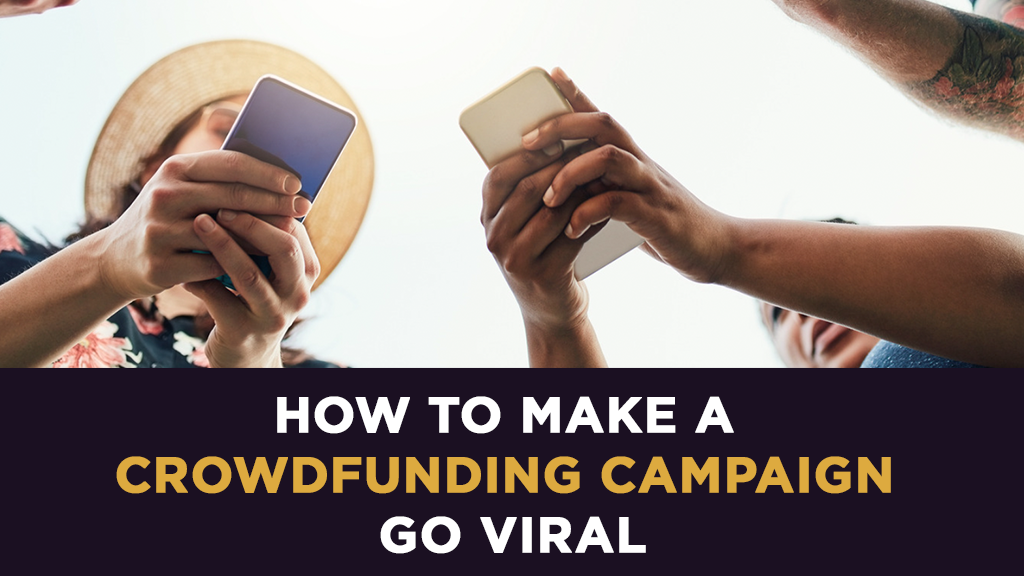When you think of crowdfunding, what comes to mind? Exploding Kittens shattering Kickstarter records, landing in Targets, Walmarts, and Barnes and Nobles everywhere. A community raising $1 million for a child’s cancer treatment. Kristen Bell and Rob Thomas galvanizing fans for a Veronica Mars film after the show’s cancellation.
We’ve all seen the viral crowdfunding campaigns, but the truth is, it’s hard to make it big. Only 1.8% of crowdfunding campaigns reach six figures, and less than 0.13% reach seven. Just on Kickstarter, there are over 3,000 live campaigns at any given time.
So how do you stand out from the crowd? You can’t simply click “launch”, cross your fingers, and hope for the best. The best campaigns are the ones that set themselves up for success before launch.
Read on to learn how to make a crowdfunding campaign go viral.
Contents
Key Takeaways
- People are more likely to support a crowdfunding campaign that has already reached its funding goal, so your priority should be to focus on getting funded.
- The one thing that viral crowdfunding campaigns have in common is that they generate massive amounts of traffic through influencer marketing, Kickbooster incentives, organic social media content, and paid advertising.
- LaunchBoom can help you implement the strategies necessary to make your crowdfunding campaign go viral.
What is a crowdfunding campaign?
Crowdfunding is the practice of raising small amounts of money from a large group of people. There are actually four primary types of crowdfunding: reward, donation, debt, and equity-based crowdfunding.
You’re probably most familiar with reward-based crowdfunding, where backers pledge in exchange for a “reward” — like an exclusive discount, early access, or a limited edition product variant. Both Kickstarter and Indiegogo are rewards-based platforms, and for the purposes of this article, we’ll focus on this type of crowdfunding.
Here’s how to create a rewards-based crowdfunding campaign in a nutshell:
- Create a campaign on a crowdfunding platform like Indiegogo or Kickstarter.
- Set your campaign duration. This is the window of time when you can receive funds. Your campaign can run anywhere from 1 to 60 days.
- Set a funding goal, the amount you want to raise during the live campaign. If you hit that goal, you become funded. Kickstarter has an “all-or-nothing” model, meaning if you don’t get funded, you receive none of the money. Indiegogo has a flexible funding model, meaning you keep whatever funds you raise.
- Your product becomes available for pre-order through your campaign page, typically at a discount.
- Backers pledge money to pre-order your product. A pledge is a promise to pay the declared amount when the campaign is over. Backers can cancel within the campaign duration. After the campaign ends (or in Kickstarter’s case, ends successfully), their credit cards get charged.
Everyone follows these same steps, but the results vary drastically. So what sets apart a $10,000 campaign from a $1 million dollar campaign?
We’ve worked with thousands of creators around the globe, raised over $100 million in crowdfunding revenue, and had our hand in viral campaigns like Author Clock, Bubble Hotel, and Polycade. We can confidently say, creators don’t go viral purely from a lucky break. It takes time, effort, and strategy.
Rocket Bike
We compiled the top ten things that viral crowdfunding campaigns do to rise above the crowd. Successful creators:
- Get funded day one
- Use a reservation funnel to build a prelaunch email list
- Connect with influencers
- Build an incentive program using Kickbooster
- Consistently post organic content on scroll-feed social platforms
- Use paid advertising to drive traffic to the campaign
- Optimize sources of traffic
- Make their campaign user-friendly
- Host physical and virtual events
- Ensure an effective post-campaign strategy
1. First things first and that’s funding
People are more likely to support a campaign that’s already funded. To maximize your chances of going viral, you want to hit your funding goal in the first 24 hours after launch.
Hitting your funding goal early has a massive snowball effect:
- Increased buyer confidence. Many backers hold off on supporting projects that aren’t funded. It’s classic social proof — once your campaign shows promise and credibility, it’s easier and easier to jump on the bandwagon.
- More traffic from the crowdfunding platform. Both Kickstarter and Indiegogo have a ranking system. Generally, the more popular your campaign, the higher you climb in the rankings. Hitting the front page is like shining a spotlight straight onto your product; you put yourself in front of millions of site visitors daily.
- More press coverage. Journalists and bloggers often scour crowdfunding platforms for interesting and innovative new projects. If your project is rapidly generating buzz, they’ll take notice.
So first things first, get funded.
2. Use a reservation funnel to build your pre-launch email list
There’s a quote often heard in business, “If you build it, they will come.” The thing is, it’s rarely that simple. And especially not in crowdfunding.
We like to say, “If you build it, they will come, only if you get the prelaunch right.”
To generate as much activity as possible on launch day, you need a solid pre-launch email list. Here’s our method for building an email list that is 30x more likely to buy. We call it the LaunchBoom Reservation Funnel:
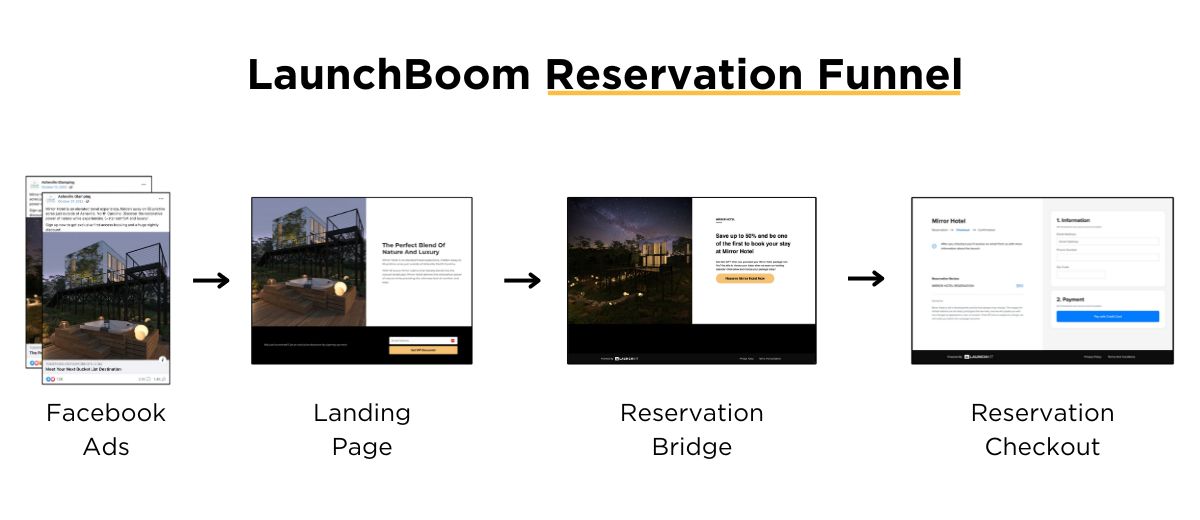
- Drive traffic: use Facebook ads to drive traffic to a landing page.
- Collect leads: on your landing page, invite people to join your email list and get notified of when you launch
- Collect reservations: after users opt in to your email list, offer them the opportunity to “reserve” the best discount by putting down a $1 deposit.
You now have two types of leads:
- Non-VIPs — leads who joined your email list but didn’t put down a deposit
- VIPs — leads who joined your email list and put down a $1 deposit
VIPs are 30x more likely to buy. Here’s why:
- Making a purchase on a website, even for only $1, is a much better indicator of purchase intent than just giving an email address.
- By tracking the $1 deposits, you can isolate your most qualified leads and optimize your advertising for purchase intent versus lead intent.
Nurture your VIP list. We recommend creating an exclusive VIP group. Most of our clients create a VIP-only Facebook group, but Discord is popular as well. Use the group to give your VIP quicker updates, more announcements, and unique opportunities to share feedback.
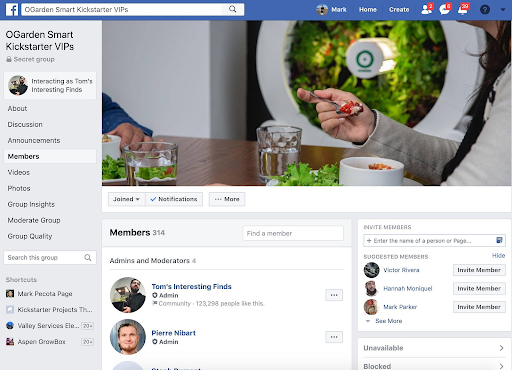
The morning of your launch, send out an announcement email. Your prelaunch email list is the primary revenue driver for the first 24 hours of your campaign. If your VIPs make a big splash on launch day, they massively turn tides in your favor.
3. Connect with Influencers
It’s undeniable — influencers mean business. 8 out of 10 consumers have purchased a product after seeing it recommended by an influencer. Effective Influencer marketing gets your product in front of more eyes and increases the chance of your campaign going viral.
Research the influencer market. Identify content creators that best match with your brand and audience. We like to use the “three R’s.”
- Relevance: how much an influencer’s audience aligns with your brand/product
- Reach: the number of people who will be exposed to the message
- Resonance: the influencer’s ability to drive measurable results with their audience
The best place to start is your own social media feed. Who do you like and follow? Search relevant hashtags and keywords. For example, if you sell a travel backpack, you might type in #travelbackpack on Instagram or travel backpack reviews on YouTube to find creators in your product market.
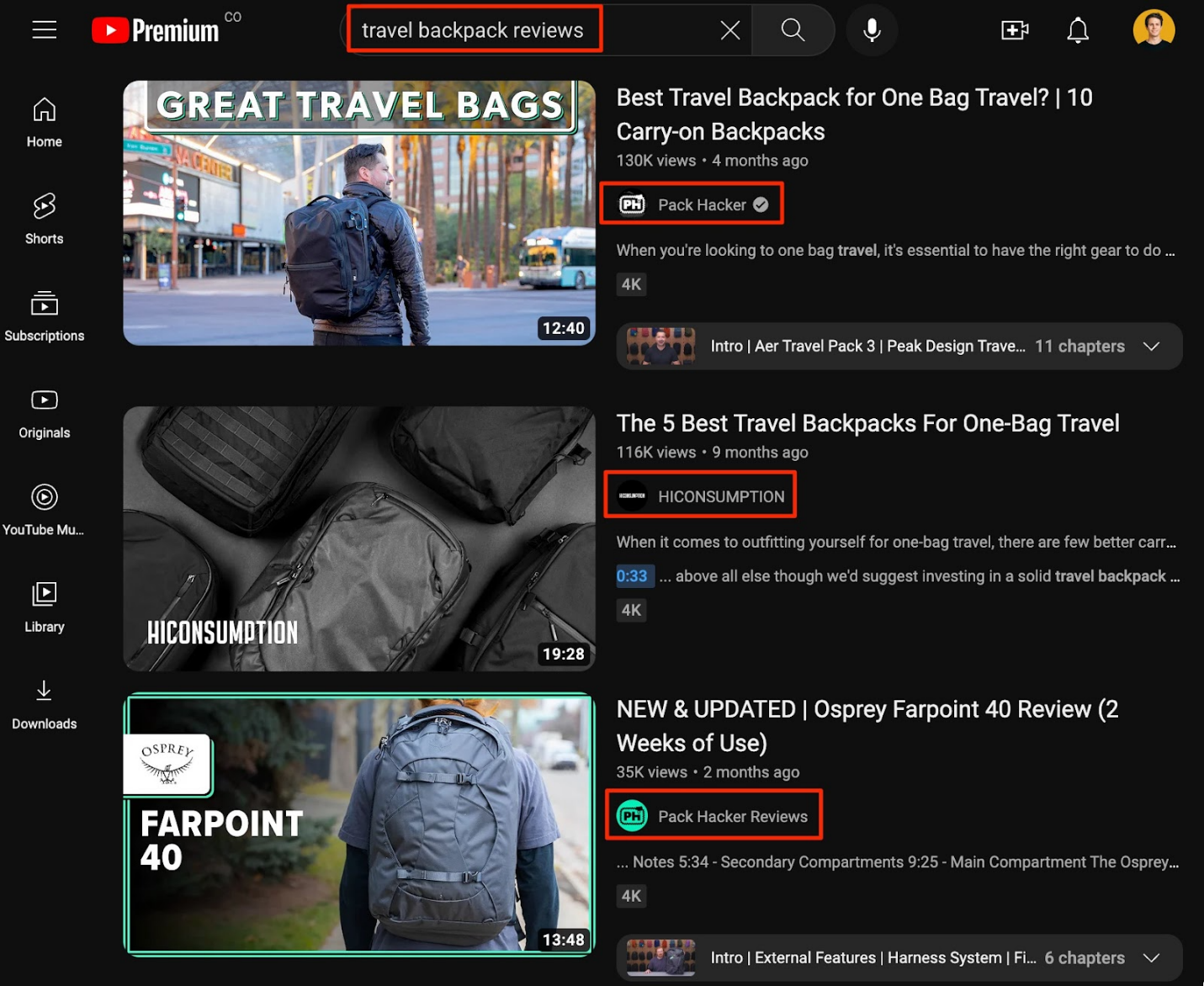
Influencer platforms like BuzzSumo and HypeAuditor are great tools. On BuzzSumo, you can filter through millions of accounts in every niche. On HypeAuditor, you can assess influencers based on metrics like brand mentions, comments to likes ratios, and audience demographic.
Another service we recommend is Brands Meet Creators. It’s essentially a job site for influencers and UGC creators (UGC stands for user-generated content, also sometimes referred to as “consumer-generated content”). It’s free to post a listing, and from there, you can sort through your applicants.
As you refine your search, remember to focus on the three R’s. If you want to go viral, hone in on partnerships that are relevant to your brand, increase your reach, and resonate with audiences.
4. Build an incentive program using Kickbooster
Kickbooster is a no-brainer for your crowdfunding campaign. It’s an affiliate and referral network platform that incentivizes people to spread the word about your product.
The best thing about Kickstarter is its massive community of “boosters,” — affiliates like publishers, bloggers, and influencers who get paid a percentage of each sale that comes from your article. With more media mentions, you get more visibility, credibility, and media logos to stick on your campaign page.
Our campaign Stealth Wallet landed an article on Gizmodo, a well-known publisher. After that came two more, InsideHook and Man of Many. Stealth Wallet raised $21,795 from 111 boosters and reached $619,411 overall on Kickstarter and Indiegogo.
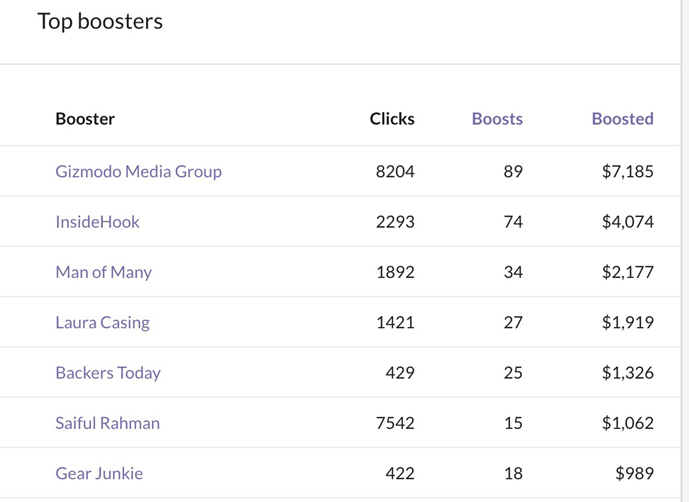
On Kickbooster, also set up a referral program to encourage backers to share your campaign with friends and family. Same as with affiliates, you only pay commissions for referrals that actually result in sales; you don’t pay for clicks or views. This simple, straightforward pricing model makes it super easy and affordable to mobilize backers and get that extra push to go viral.
5. Consistently post organic content on scroll-feed social platforms
To make your crowdfunding campaign go viral, post organic content on social media platforms like TikTok, Instagram, Twitter, and Facebook. Unlike influencer or sponsored content, organic content is unpaid and appears naturally in people’s social feeds.
Organic content is ideal for attracting and engaging customers without breaking the bank on advertising spend. But what it saves in dollars, it demands back in time and effort. Before you build a loyal following and establish yourself as an industry authority, you have to cut through a barrage of noise and competition.
That means posting consistently. And by consistently, we mean every day. Social media audiences are hungry and have low attention spans. You want to stay at the forefront of your target’s mind. Set a regular posting schedule and plan your content in advance. Hootsuite is a great platform for scheduling and staying on top of your posts.
Social media content should be consistent, engaging, informative, and valuable. Most importantly, it needs to be targeted and relevant to your audience. Facebook and Instagram track huge amounts of audience data so you can figure out what’s working and what’s not. Continue fine-tuning your content to optimize your reach.
Use social media to announce campaign updates, shout out new backers, and celebrate milestones. Share infographics and industry insights to showcase your expertise and build credibility in your niche. And the best way to go viral on social media? Make a viral video.
How to create a viral video campaign
Unruly analyzed 430 billion video views and determined the two most powerful drivers of viral success are:
- Psychological response — how the content makes you feel
- Social motivation — why you want to share the content with others
The higher the emotional intensity, the more likely people are to share your content. That’s why it’s often videos that go viral on social media. Visual storytelling evokes a huge depth and range of feeling.
Here are our tips on how to create a viral video for your crowdfunding campaign:
- Define your message and target audience.
- Make your video concise, engaging, and visually appealing.
- Start with a compelling hook. The first few seconds should grab the viewer’s attention and set the tone for the rest of the video.
- Use emotional storytelling to draw viewers into your video.
- Inspire a range of emotions. Don’t be afraid to evoke both positive and negative emotions like excitement, amusement, anger, and fear.
- Showcase your product or project in action and highlight its unique features and benefits.
- Tailor the video for different platforms. A YouTube short may need a different caption, thumbnail, or hashtags than a Facebook video.
- Use humor or surprise to make the video memorable and shareable.
How To Make A Video Go Viral
Now that you have a unique and shareable video, it’s time to make it go viral. Before posting publicly, give your VIPs a sneak peek. Remember, VIPs drive early traffic. You want them excited and talking the minute your video goes live.
Then, it’s time to post! Share the video on your crowdfunding page, blog, email newsletter, and social media channels. Encourage your existing network to share the video with friends and family who might be interested. Send it to your influencers and bloggers to promote to their followers. Use paid advertising on social media to increase visibility and reach.
6. Use paid advertising to drive traffic to the campaign
To go viral, you need to expand your reach to a much larger pool. That’s where paid advertising comes in. If organic content is a slow burn, paid advertising is the exact opposite — it’s an expensive but surefire way to build an audience fast.
Keep in mind, a wider reach doesn’t mean an indiscriminate reach. You still want to be precise and strategic with your targeting. On Meta Advertising, you can generate different kinds of audiences:
- Interest audiences: Audiences who are interested in people, brands, organizations, communities, and Facebook pages relevant to your product
- Lookalike audiences: Audiences generated based on a sample list of leads. We recommend pulling two sample lists from your prelaunch list: 1) your VIPs, and 2) everyone who opened an email from you. Upload both into Meta.
In your ads, use appealing imagery, compelling copy, and a clear call to action to get people onto your campaign page.
If your campaign is funded at this point, lean into that. Remember what we said earlier about social proof? People are more likely to back a campaign when they see others are already on board. Here’s an ad we made for the VAVA 4k Laser Projector.
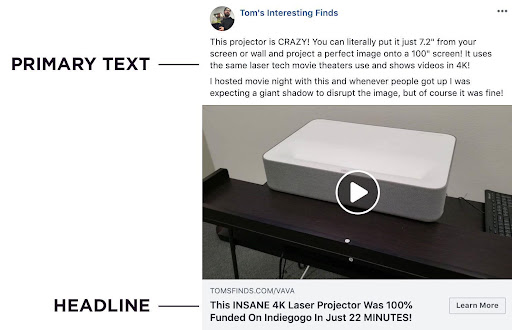
By saying things like 100% Funded and just 22 MINUTES!, we leveraged our existing success to cascade into bigger and bigger sales. VAVA raised $1.8 million on Indiegogo.
7. Viral crowdfunding: It’s all about the traffic
When you look at multi-million-dollar campaigns, it’s easy to wonder, “Where is all this money coming from? The campaign creator must have hundreds of sources of traffic to raise this much money!”
It can be confusing to know where to start. One thing’s for sure: The more traffic your campaign receives, the more likely it goes viral. And while there are hundreds of traffic sources, most of them fall into one of four distinct categories. We call them the Four Horsemen of Traffic, and we’ve covered all four already:
- Your prelaunch email list leads the charge. The goal of prelaunch is to immediately drive sales in the first 24 hours of your campaign. Ideally, this traffic alone gets your campaign funded.
- Online advertising fights until the end. Use paid ads throughout your campaign to sustain traffic.
- PR and influencer marketing fights in waves. Media mentions and influencer partnerships get you spikes in traffic.
- Your crowdfunding platform never fights alone. Indiegogo and Kickstarter are huge communities. By getting on the front page, you reach the millions of visitors browsing these sites daily. But you can’t climb the rankings unless you already have traffic, and you can’t get traffic unless you have Horsemen #1, 2, and 3.
Use the Four Horsemen to drill down on the most essential sources of traffic for your campaign. Don’t let yourself get pulled in a million different directions. By strategically allocating your time and marketing spend between your vital traffic sources, you’ll have the formula for going viral.
8. Make it user-friendly
All your efforts so far have culminated in one purpose: getting viewers onto your campaign page. Now, you need to turn viewers into buyers. If your campaign page is disorganized, confusing, and unintuitive, your marketing investment goes straight down the drain.
Your campaign page should be user-friendly, inviting, and accessible. Users may access your crowdfunding campaign from smartphones, tablets, or desktop computers, so ensure your content is compatible across devices.
Make it as easy as possible for viewers to get the information they need. Here are three tips on user-friendly design.
1. Use feature clouds
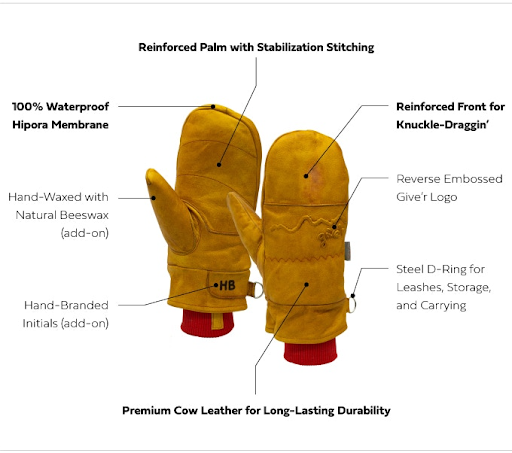
Show all the core features of your product in one graphic. It’s much more digestible than a wall of text. Here’s an example from our Give’r campaign, which raised $1,356,709.
2. Use GIFs
GIFs are a great way to show your product in action and they come in handy when a still image just won’t do. We often create GIFs from the campaign video to showcase key features.
3. Build a visual hierarchy
Have a clear, consistent visual hierarchy of headlines, subheadlines, and supporting copy. Keep design styles consistent throughout the page. These visual cues guide viewers through your content and draw their eye to what’s most important.
We recommend uploading your headlines and subheadlines as images. For Give’r, we used this design for our headlines:

And we used this design style for our subheadlines:

4. Bold and italicize text you want to emphasize
Bold and italicize important text to draw attention to key features and benefits. Here’s how we did it for Give’r:
9. Host physical and virtual events
Marketing isn’t just digital ads and social media. Events help you build your network and increase brand awareness. Plus they keep existing backers engaged, encouraging them to generate more buzz around your campaign.
Here are some ideas for hosting physical and virtual events:
- Host an in-person launch party to kick off your crowdfunding campaign. Invite local backers, influencers, and media contacts.
- Run product demos to showcase your product or prototype.
- Organize educational workshops, webinars, or classes to attract customers with relevant interests and hobbies.
- Let backers tour your workspace or product facility.
Also take advantage of external events. Set up booths at trade shows and industry fairs to get your logo in front of more eyes. If you’re in the games industry, event marketing is especially huge. There are a couple major conventions you want to hit, like GAMA Expo, Origins Game Fair, and GenCon.
10. Ensure an effective post-campaign strategy
You hit your goal! Your campaign might be over, but your work definitely isn’t.
We highly recommend moving your crowdfunding to Indiegogo InDemand as soon as your campaign ends. InDemand enables any campaign that meets its initial goal to continue raising funds after the live campaign is over.
InDemand keeps the momentum going on a viral campaign. Our client LoftTek started on InDemand with the $757,079 they raised on Kickstarter. InDemand carried them into the $1 million club — LoftTek raised a grand total of $1,041,308 in presale revenue.
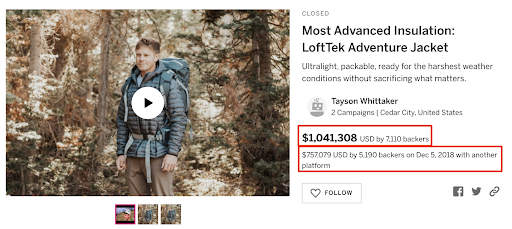
As you enter the post-campaign phase, remember to take care of your backers. Send personalized emails thanking them for their support. Keep them updated on your production and fulfillment timeline. Stay on top of comments and messages.
At the end of the day, going viral isn’t everything. Coolest Cooler raised $13 million on Kickstarter and struggled for months afterward to stay afloat. Pebble sold all its assets to Fitbit three months after its last multi-million-dollar campaign.
Investors and retailers are watching for companies that fulfill on time, provide high quality customer experiences, and build strong customer loyalty. Beyond just two minutes in the limelight, your campaign needs to propel you to long-term success.
Everyone wants to be the next campaign to blow up overnight and hit $1 million on a $10,000 goal. It’s not easy achieving crowdfunding superstardom, but a solid launch strategy will maximize your chances of success.
Today, we learned how to make your make your crowdfunding campaign go viral:
- How to set a strategic funding goal
- How to generate buzz through the prelaunch
- How to boost your Kickstarter campaign through marketing
- How to nail your post-campaign strategy
Creating a successful crowdfunding campaign FAQs
How does a project go viral on Kickstarter?
If you’re launching on Kickstarter, you have a number of Kickstarter-specific tools to leverage. Here are our tips on how to boost Kickstarter campaign success:
- Launch in the morning. We’ve analyzed 342,287 Kickstarter projects and determined the best time to launch a Kickstarter is 8am EST.
- Get on Kickstarter’s newsletter. It drives massive traffic to your campaign. Kickstarter is pretty selective on who they showcase, but it doesn’t hurt to reach out to their team and ask.
- Aim for a “Project We Love” badge. Kickstarter bestows this badge to campaigns they find especially innovative and unique. In your campaign, highlight what makes you different from the crowd.
- Use the Kickstarter backer survey to keep backers engaged and collect vital information on your target audience.
How do people successfully crowdfund?
Successful campaigns require time, effort, and strategy starting from the prelaunch, throughout the campaign, and in the post-campaign. If you want to launch a viral crowdfunding campaign, make sure you:
- Pick a funding goal that can adequately cover your costs but is not too high that you lose momentum.
- Use a reservation funnel to build a prelaunch email list and drive sales on launch day.
- Partner with influencers to widen your reach to relevant audiences.
- Create a referral or affiliate incentive program on Kickbooster.
- Consistently post organic content to build a social media following and establish yourself as an industry authority.
- Use paid advertising to drive traffic throughout your campaign.
- Understand and leverage the Four Horsemen of Traffic.
- Make your campaign page as user-friendly as possible.
- Host physical and virtual events to engage existing backers while attracting new ones.
- Don’t forget about your post-campaign strategy.
Why do so many crowdfunding campaigns fail?
Many product creators come to us after they tried launching on their own and failed the first time around. The most common mistakes we see are:
- Not positioning your product effectively
- Not investing enough in the prelaunch
- Not building a VIP community
And the last reason why crowdfunding campaigns fail? The creator tried to do everything on their own. Knowing the best crowdfunding strategies is one thing, but implementing them is another. At LaunchBoom, we have a team of over twenty crowdfunding experts ready to help. Want to be the next project that goes viral? Let’s talk.

